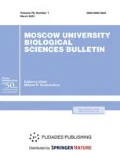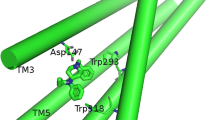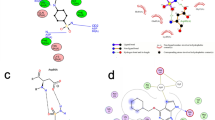Abstract
A voltage-gated potassium channel Kv10.2 is expressed in the nervous system, but its functions and involvement in the development of human disease remain poorly understood. Mutant forms of the Kv10.2 channel were found in patients with epileptic encephalopathy and autism. Molecular modeling of the channel spatial structure is an important tool for gaining knowledge about the molecular aspects of the channel functioning and mechanisms responsible for pathogenesis. In the present work, molecular modeling of the helical fragment of the human Kv10.2 (hEAG2) C-terminal domain in dimeric, trimeric, and tetrameric forms was performed. The stability of all forms was confirmed by molecular dynamics simulation. Contacts and interactions, stabilizing the structure, were identified.
Similar content being viewed by others
References
Saganich, M.J, Vega-Saenz de Miera, E., Nadal, M.S., Baker, H., Coetzee, W.A., and Rudy, B., Cloning of components of a novel subthreshold-activating K(+) channel with a unique pattern of expression in the cerebral cortex, J. Neurosci., 1999, vol. 19, no. 24, pp. 10789–10802.
Asher, V., Sowter, H., Shaw, R., Bali, A., and Khan, R, Eag and HERG potassium channels as novel therapeutic targets in cancer, World J. Surg. Oncol., 2010, vol. 8, no. 1, p.113.
Yang, Y., Vasylyev, D.V., Dib-Hajj, F., Veeramah, K.R., Hammer, M.F., Dib-Hajj, S.D., and Waxman, S.G., Multistate structural modeling and voltageclamp analysis of epilepsy/autism mutation Kv10.2-R327H demonstrate the role of this residue in stabilizing the channel closed state, J. Neurosci., 2013, vol. 33, no. 42, pp. 16586–16593.
Wulff, H., Pardo, L.A., and Castle, N.A, Voltagegated potassium channels as therapeutic targets, Nat. Rev. Drug Discov., 2009, vol. 8, no. 12, pp. 982–1001.
Ju, M. and Wray, D, Molecular identification and characterisation of the human eag2 potassium channel, FEBS Lett., 2002, vol. 524, nos 1-3, pp. 204–210.
Schönherr, R., Gessner, G., Löber, K., and Heinemann, S.H., Functional distinction of human EAG1 and EAG2 potassium channels, FEBS Lett., 2002, vol. 514, nos. 2–3, pp. 204–208.
Karlova, M.G., Pischalnikova, A.V., Ramonova, A.A., Moisenovich, M.M., Sokolova, O.S., and Shaitan, K.V, In vitro fluorescence assay to study the folding of Kv ion channels, Biophysics, 2011, vol. 56, no. 2, pp. 243–249.
Ludwig, J., Owen, D., and Pongs, O., Carboxy-terminal domain mediates assembly of the voltage-gated rat ether-à-go-go potassium channel, EMBO J., 1997, vol. 16, no. 21, pp. 6337–6345.
Jenke, M., Sánchez, A., Monje, F., Stühmer, W., Weseloh, R.M., and Pardo, L.A., C-terminal domains implicated in the functional surface expression of potassium channels, EMBO J., 2003, vol. 22, no. 3, pp. 395–403.
Wiener, R., Haitin, Y., Shamgar, L., Fernández-Alonso, M.C., Martos, A., Chomsky-Hecht, O., Rivas, G., Attali, B., and Hirsch, J.A, The KCNQ1 (Kv7.1) COOH terminus, a multitiered scaffold for subunit assembly and protein interaction, J. Biol. Chem., 2008, vol. 283, no. 9, pp. 5815–5830.
Ju, M. and Wray, D, Molecular regions responsible for differences in activation between hEAG channels, Bio-chem. Biophys. Res. Commun., 2006, vol. 342, no. 4, pp. 1088–1097.
Stevens, L., Ju, M., and Wray, D, Roles of surface residues of intracellular domains of heag potassium channels, Eur. Biophys. J., 2009, vol. 38, no. 4, pp. 523–532.
Sokolova, O.S., Shaitan, K.V., Grizel, A.V., Popinako, A.V., Karlova, M.G., and Kirpichnikov, M.P, Threedimensional structure of human voltage-gated ion channel Kv10.2 studied by electron microscopy of macromolecules and molecular modeling, Russ. J. Bioorganic Chem., 2012, vol. 38, no. 2, pp. 152–158.
Whicher, J.R. and Mackinnon, R, Structure of the voltage-gated K+ channel Eag1 reveals an alternative voltage sensing mechanism, Science, 2016, vol. 353, no. 6300, pp. 664–669.
Novoseletsky, V.N., Volyntseva, A.D., Shaitan, K.V., Kirpichnikov, M.P., and Feofanov, A.V, Modeling of the binding of peptide blockers to voltage-gated potassium channels: Approaches and evidence, Acta Naturae, 2016, vol. 8, no. 2, pp. 35–46.
Glukhov, G.S., Popinako, A.V., Grizel, A.V., Shaitan, K.V., and Sokolova, O.S, The structure of a human voltage-gated potassium Kv10.2 channel which lacks a cytoplasmic pas domain, Biophysics, 2016, vol. 61, no. 4, pp. 591–595.
Van Der Spoel, D., Lindahl, E., Hess, B., Groenhof, G., Mark, A.E., and Berendsen, H.J.C., GROMACS: Fast, flexible, and free, J. Comput. Chem., 2005, vol. 26, no. 16, pp. 1701–1718.
Strelkov, S.V. and Burkhard, P, Analysis of a-helical coiled coils with the program TWISTER reveals a structural mechanism for stutter compensation, J. Struct. Biol., 2002, vol. 137, nos. 1–2, pp. 54–64.
Baker, N.A., Sept, D., Joseph, S., Holst, M.J., and McCammon, J.A, Electrostatics of nanosystems: Application to microtubules and the ribosome, Proc. Natl. Acad. Sci. U.S.A., 2001, vol. 98, no. 18, pp. 10037–10041.
Schymkowitz, J., Borg, J., Stricher, F., Nys, R., Rousseau, F., and Serrano, L, The FoldX web server: An online force field, Nucleic Acid Res., 2005, vol. 33, suppl. 2, pp. W382–W388.
Vincent, T.L., Green, P.J., and Woolfson, D.N., LOGICOIL–multi-state prediction of coiled-coil oligomeric state, Bioinformatics, 2013, vol. 29, no. 1, pp. 69–76.
Rao, J.N., Rivera-Santiago, R., Li, X.E., Lehman, W., and Dominguez, R., Structural analysis of smooth muscle tropomyosin a and ß isoforms, J. Biol. Chem., 2012, vol. 287, no. 5, pp. 3165–3174.
Xu, Q. and Minor, D.L, Crystal structure of a trimeric form of the K(V)7.1 (KCNQ1) A-domain tail coiledcoil reveals structural plasticity and context dependent changes in a putative coiled-coil trimerization motif, Protein Sci., 2009, vol. 18, no. 10, pp. 2100–2114.
Kammerer, R., Kostrewa, D., Progias, P., Honnappa, S., Avila, D., Lustig, A., Winkler, F.K., Pieters, J., and Steinmetz, M.O., A conserved trimerization motif controls the topology of short coiled coils, Proc. Natl. Acad. Sci. U.S.A., 2005, vol. 102, no. 39, pp. 13891–13896.
Howard, R.J., Clark, K.A., Holton, J.M., and Minor, D.L, Structural insight into KCNQ (Kv7) channel assembly and channelopathy, Neuron, 2007, vol. 53, no. 5, pp. 663–675.
Sadovnichy, V., Tikhonravov, A., Voevodin, V., and Opanasenko, V, Supercomputing at Moscow State University, in Contemporary High Performance Computing: From Petascale toward Exascale, Vetter, J.S., Ed., Boca Raton, FL: Chapman & Hall/CRC, 2013, pp. 283–307.
Author information
Authors and Affiliations
Corresponding author
About this article
Cite this article
Novoseletsky, V.N., Volyntseva, A.D., Shaitan, K.V. et al. Molecular modeling of the tetramerization domain of human potassium channel Kv10.2 in different oligomeric states. Moscow Univ. Biol.Sci. Bull. 72, 69–73 (2017). https://doi.org/10.3103/S0096392517020031
Received:
Accepted:
Published:
Issue Date:
DOI: https://doi.org/10.3103/S0096392517020031




